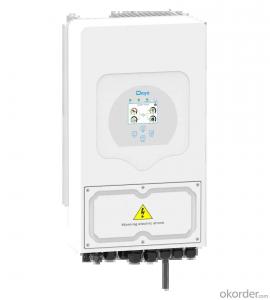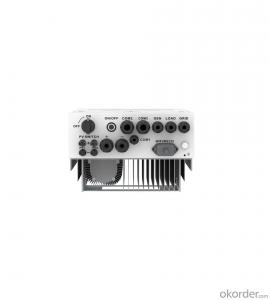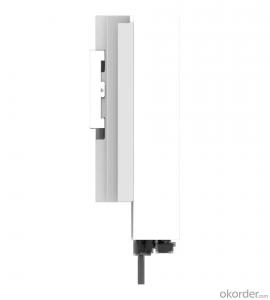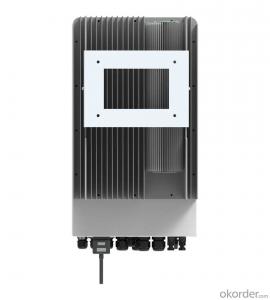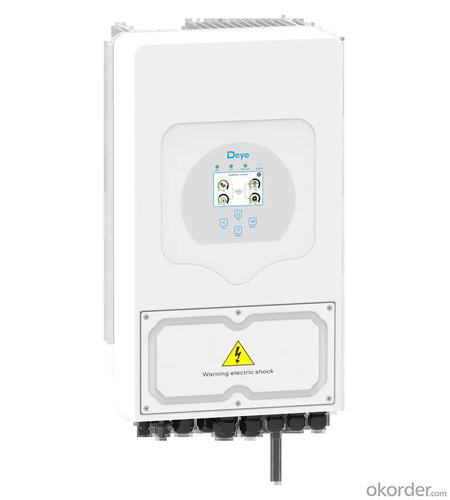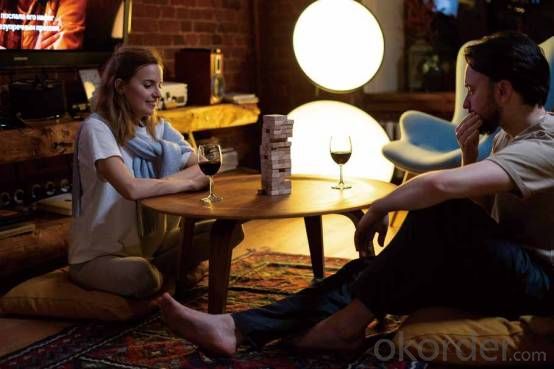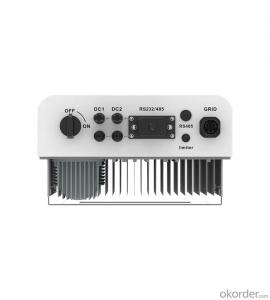Loom Solar Inverter Sun-5k-sg03lp1-eu 5kw Single Phase 2 MPPT Hybrid Inverter Low Voltage Battery
- Loading Port:
- Ningbo
- Payment Terms:
- TT OR LC
- Min Order Qty:
- 100 pc
- Supply Capability:
- 5000 pc/month
OKorder Service Pledge
OKorder Financial Service
You Might Also Like
Specification
SUN 5K-SG,hybrid inverter, is suitable for residential and light commercial use, maximizing self-consumption rate of solar energy and increasing your energy impendence. During the day, the PV system generates electricity which will be provided to the loads initially. Then, the excess energy will charge the battery via SUN 6K-SG. Finally, the stored energy can be released when the loads require it. The battery can also be charged by the diesel generator to ensure uninterrupted supply in the event of grid blackout.
100% unbalanced output, each phase; Max. output up to 50% rated power
DC couple and AC couple to retrofit existing solar system
Max. 16pcs parallel for on-grid and off-grid operation; Support multiple batteries parallel
Max. charging/discharging current of 240A
48V low voltage battery, transformer isolation design
6 time periods for battery charging/discharging
| Model | SUN-5K -SG03LP1-EU | |
| Battery Input Data | ||
| Battery Type | Lead-acid or Li-lon | |
| Battery Voltage Range (V) | 40~60 | |
| Max. Charging Current (A) | 120 | |
| Max. Discharging Current (A) | 120 | |
| External Temperature Sensor | Yes | |
| Charging Curve | 3 Stages / Equalization | |
| Charging Strategy for Li-Ion Battery | Self-adaption to BMS | |
| PV String Input Data | ||
| Max. DC Input Power (W) | 6500 | |
| Rated PV Input Voltage (V) | 370 (125~500) | |
| Start-up Voltage (V) | 125 | |
| MPPT Voltage Range (V) | 150-425 | |
| Full Load DC Voltage Range (V) | 300-425 | |
| PV Input Current (A) | 13+13 | |
| Max. PV ISC (A) | 17+17 | |
| Number of MPPT / Strings per MPPT | 2/1+1 | |
| AC Output Data | ||
| Rated AC Output and UPS Power (W) | 5000 | |
| Max. AC Output Power (W) | 5500 | |
| AC Output Rated Current (A) | 22.7 | |
| Max. AC Current (A) | 25 | |
| Max. Continuous AC Passthrough (A) | 35 | |
| Peak Power (off grid) | 2 time of rated power, 10 S | |
| Power Factor | 0.8 leading to 0.8 lagging | |
| Output Frequency and Voltage | 50/60Hz; L/N/PE 220/230Vac (single phase) | |
| Grid Type | Single Phase | |
| DC injection current (mA) | THD<3% (Linear load<1.5%)< td=""> | |
| Efficiency | ||
| Max. Efficiency | 97.60% | |
| Euro Efficiency | 97.00% | |
| MPPT Efficiency | 99.90% | |
| Protection | ||
| Integrated | PV Input Lightning Protection, Anti-islanding Protection, PV String Input Reverse Polarity Protection, Insulation Resistor Detection, Residual Current Monitoring Unit, Output Over Current Protection, Output Shorted Protection, Surge protection | |
| Output Over Voltage Protection | DC Type II/AC Type III | |
| Certifications and Standards | ||
| Grid Regulation | CEI 0-21, VDE-AR-N 4105, NRS 097, IEC 62116, IEC 61727, G99, G98, VDE 0126-1-1, RD 1699, C10-11 | |
| Safety EMC / Standard | IEC/EN 61000-6-1/2/3/4, IEC/EN 62109-1, IEC/EN 62109-2 | |
| General Data | ||
| Operating Temperature Range (℃) | -45~60℃, >45℃ derating | |
| Cooling | Natural cooling | |
| Noise (dB) | <30 dB | |
| Communication with BMS | RS485; CAN | |
| Weight (kg) | 20.5 | |
| Size (mm) | 330W x 580H x232D IP65 | |
| Protection Degree | IP65 | |
| Installation Style | Wall-mounted | |
| Warranty | 5 years | |
- Q: Can a solar inverter be used with a solar-powered air conditioner?
- Yes, a solar inverter can be used with a solar-powered air conditioner. The solar inverter is responsible for converting the direct current (DC) produced by the solar panels into alternating current (AC) that can be used to power electrical appliances, including air conditioners. By connecting the solar inverter to the solar panels and then to the solar-powered air conditioner, the AC produced by the inverter can be utilized to run the air conditioner, effectively making it solar-powered.
- Q: How do you choose the right voltage rating for a solar inverter?
- When choosing the right voltage rating for a solar inverter, it is important to consider a few factors. Firstly, you should check the voltage rating of your solar panels to ensure compatibility with the inverter. Secondly, consider your system's voltage requirements, including the voltage of your battery bank or grid connection. Lastly, take into account the distance between your inverter and the solar panels, as voltage drop can occur over long distances. By considering these factors, you can select a solar inverter with the appropriate voltage rating for optimal performance and efficiency.
- Q: Can a solar inverter be used in harsh environmental conditions?
- A solar inverter is capable of operating in harsh environmental conditions. It can withstand a wide range of environmental factors, including extreme temperatures, humidity, dust, and vibrations. Manufacturers often construct solar inverters using durable materials and apply protective coatings to shield them from severe weather conditions. Furthermore, many solar inverters are equipped with advanced cooling mechanisms to prevent overheating in hot climates. Nevertheless, it is crucial to consider that the durability and performance of a solar inverter in harsh conditions may differ depending on the brand and model. To guarantee optimal performance and longevity, it is advised to select a reliable and high-quality solar inverter specifically designed for use in harsh environmental conditions.
- Q: Can a solar inverter be used in a net metering system?
- Yes, a solar inverter can be used in a net metering system. A solar inverter is an essential component of a solar energy system, as it converts the direct current (DC) electricity generated by solar panels into alternating current (AC) electricity that can be used to power homes and businesses. In a net metering system, excess electricity generated by the solar panels is fed back into the grid, and a solar inverter facilitates this process by synchronizing the electricity produced with the utility grid.
- Q: How is the output voltage of a solar inverter regulated?
- The output voltage of a solar inverter is regulated through the use of control circuitry and power electronics components. These components monitor the input voltage from the solar panels and adjust the output voltage to meet the desired specifications. The control circuitry ensures that the output voltage remains stable and within the required range, even when there are fluctuations in the input voltage or varying load conditions.
- Q: How does a solar inverter synchronize with the grid frequency?
- A solar inverter synchronizes with the grid frequency by continuously monitoring the frequency of the electrical power supplied by the grid. It adjusts its own output frequency to match the grid frequency using a built-in control mechanism. This synchronization ensures that the solar inverter's power is in phase with the grid power, allowing it to smoothly inject electricity into the grid without causing disruptions or power quality issues.
- Q: How does a solar inverter handle voltage transients?
- A solar inverter handles voltage transients by employing various protective mechanisms such as surge protection devices and voltage regulation techniques. These mechanisms help to stabilize and control the voltage level, ensuring that the inverter is not affected by sudden spikes or drops in voltage. Additionally, the inverter may include features like overvoltage and undervoltage protection, which help to prevent damage to the system during voltage transients.
- Q: Are solar inverters weather-resistant?
- Yes, solar inverters are typically weather-resistant. They are designed to withstand various weather conditions such as rain, snow, and extreme temperatures. However, it is important to note that prolonged exposure to harsh weather conditions could potentially affect their performance and lifespan. Regular maintenance and proper installation can help ensure their durability and longevity.
- Q: Can a solar inverter be used in remote areas without access to the grid?
- Yes, a solar inverter can be used in remote areas without access to the grid. Solar inverters are designed to convert the direct current (DC) electricity generated by solar panels into alternating current (AC) electricity that can be used to power electrical appliances. In remote areas, solar panels can be installed to harness sunlight and convert it into electricity, which can then be used through the solar inverter to provide power to homes, businesses, or any other electrical devices without the need for a grid connection.
- Q: How does a solar inverter handle voltage flicker?
- A solar inverter handles voltage flicker by regulating and stabilizing the voltage output. It detects any fluctuations in the grid voltage caused by flicker and adjusts the output accordingly to maintain a consistent and stable voltage for the connected solar panels or other electrical devices.
Send your message to us
Loom Solar Inverter Sun-5k-sg03lp1-eu 5kw Single Phase 2 MPPT Hybrid Inverter Low Voltage Battery
- Loading Port:
- Ningbo
- Payment Terms:
- TT OR LC
- Min Order Qty:
- 100 pc
- Supply Capability:
- 5000 pc/month
OKorder Service Pledge
OKorder Financial Service
Similar products
Hot products
Hot Searches
Related keywords
